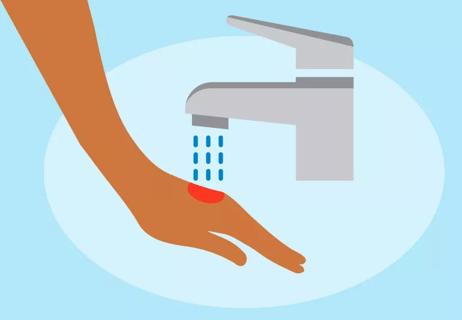Keeping you + your family safe

So many dangers lurk in your kitchen — knives, open flames, boiling water, oh my! Whether you’re a klutz or grace under fire, spending time in the kitchen could get dicey.
Advertisement
Cleveland Clinic is a non-profit academic medical center. Advertising on our site helps support our mission. We do not endorse non-Cleveland Clinic products or services. Policy
Thomas Waters, MD, emergency medicine physician, discusses the kitchen injuries he most often sees in the emergency department. Plus, he offers helpful tips on how to know if you can handle the injury at home or if it requires a trip to the ER.
Learned the hard way that the oven mitt has a hole in it? Burns can and do happen in the kitchen. Make a beeline to the emergency department if the burn:
“With any burn, your first action happens at home: Cool the burn as quickly as possible,” says Dr. Waters. “It’s an old wives’ tale that butter works, so stick with cold water.”
Dr. Waters says you should never be afraid or feel silly seeking care in the emergency department. “If you’re asking yourself whether you should go to the emergency room, the answer is usually, ‘Yes.’”
Cuts and lacerations are common kitchen injuries, even if your knives haven’t been sharpened in a decade. Seek emergency care when:
Advertisement
First things first: Apply direct pressure to the area to stop the bleeding. Then assess the situation.
“Deep cuts put your tendons, nerves, arteries, veins and even bones at risk,” says Dr. Waters. “If you get the feeling the cut is pretty deep, then a trip to the ER is a good idea.”
Hot peppers, cleaning solutions and lemon juice sometimes land where they shouldn’t. Head to the ER if your:
“If you come in contact with an irritant, rinse the affected area with lukewarm water,” says Dr. Waters. “For skin irritation from something like a hot pepper, you may find milk is better at neutralizing the area and provides more relief than water.”
Maybe you needed strong chemicals to clean up the royal mess you made, or perhaps the cacciatore caught on fire. Either way, you inhaled irritating fumes. Get to the emergency department if:
“Inhalation concerns happen more for people who have an airway condition like asthma,” says Dr. Waters. “Treat at home with your airway medications. If it doesn’t get better, then head to the ER.”
Did you fall from a step stool while reaching for the slow cooker? Or maybe you slipped on the spilled milk your toddler’s crying over? Injuries aren’t likely when falling from a standing position but never say never. Get to the emergency department if you:
“I want people to understand they don’t need to feel guilty about coming to the emergency room,” says Dr. Waters. “It’s more dangerous to let something go for two days and end up with a problem that could have been avoided if you’d received care right away.”
Dr. Waters also offers this gem: Never stick your hand in the garbage disposal (or at least unplug it first).
Advertisement
Learn more about our editorial process.
Advertisement

There’s no way to stop it once a heart attack is happening, but the most important thing you can do is to call for help

Get quick relief with ice chips, popsicles, milk and saltwater

Resist the urge to peel, and treat your healing skin to some much-needed hydration

Ice, saline rinses, OTC pain meds and honey can all help soothe a troubled taster

Ice (and icy water) can actually make a burn worse, not better

Keep healthy foods on hand, like tuna packets, canned veggies and fruits, and beans and rice

Establish rules and have a safety plan in place

Most post-fire deaths occur because of smoke inhalation

Type 2 diabetes isn’t inevitable with these dietary changes

Applying a hot or cold compress can help with pain